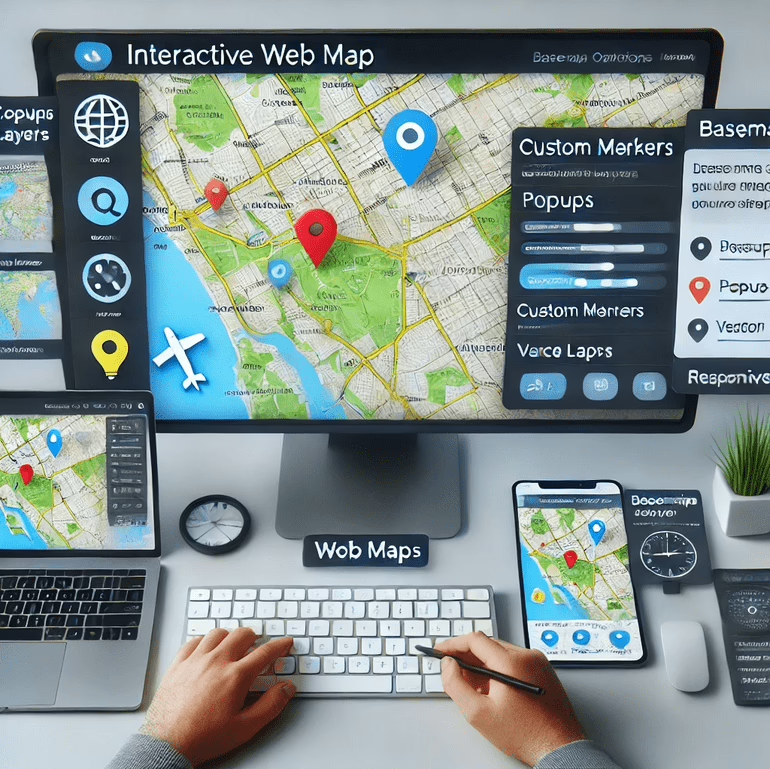In today’s digital landscape, interactive maps are no longer just a novelty—they’re a necessity for businesses across industries. Whether used in real estate platforms, weather tracking systems, logistics dashboards, or tourism guides, maps serve as a vital tool for engaging users and providing real-time, actionable data. One technology that’s made it easier than ever to integrate maps into web applications is Leaflet, a lightweight and open-source JavaScript library.
Leaflet stands out for its simplicity, flexibility, and performance, making it a favorite among developers who need to create responsive and interactive maps. This blog delves into how Leaflet works, its key features, and how Curate Consulting Services can assist businesses in finding specialized talent to leverage this powerful tool.
What is Leaflet?
Leaflet is a JavaScript library designed for creating fast and customizable interactive maps on websites and web applications. It’s free, open-source, and is built to work efficiently on both desktop and mobile devices. Its lightweight structure (about 42KB of JS) ensures that web pages remain fast and responsive, while its robust functionality makes it ideal for both basic and advanced mapping applications.
Since its release, Leaflet has garnered widespread use across industries due to its flexibility and adaptability. It integrates seamlessly with various mapping services like OpenStreetMap, Google Maps, Bing, and other custom tile providers, offering developers the freedom to choose the best base layer for their project.
Why Choose Leaflet for Web Mapping?
1. Lightweight and Fast Loading
Performance is crucial in web development, and one of Leaflet’s major strengths is its lightweight structure. Unlike heavier mapping libraries that can bog down page load times, Leaflet is optimized to ensure your website or application remains fast and responsive. The library doesn’t add excessive overhead, ensuring a smooth user experience even when multiple maps and layers are used.
For businesses, this means you can create rich, interactive experiences without sacrificing performance—keeping users engaged while ensuring swift navigation across your platform.
2. Open Source Flexibility
Leaflet’s open-source nature makes it accessible to everyone. Whether you’re a startup developing your first web app or a large enterprise integrating complex mapping solutions, Leaflet provides a cost-effective and customizable solution. It is distributed under the BSD-2-Clause license, allowing users to modify and distribute it freely. This empowers developers to tailor Leaflet to their specific needs without the restrictions that often come with proprietary software.
The open-source community has also contributed an abundance of plugins that extend the core functionality of Leaflet. These plugins cover use cases ranging from geocoding and heatmaps to spatial clustering and data visualization, further boosting the utility of this lightweight library.
3. Cross-Platform Compatibility
Leaflet works across all major web browsers and platforms, ensuring a consistent user experience whether your audience is accessing the map from a desktop, tablet, or mobile device. This cross-platform compatibility makes it an ideal solution for businesses with diverse user bases or global audiences.
4. Basemap Agnostic
One of Leaflet’s most attractive features is its ability to work with virtually any map tile provider. Whether you’re using the widely popular OpenStreetMap, want to switch to Google Maps, or need custom map tiles, Leaflet can handle it. This basemap agnosticism allows developers to create personalized and branded mapping experiences that cater to their specific business needs.
Leaflet’s Core Features
Marker and Popup Support
Leaflet makes it easy to add markers and custom popups to maps. This is particularly useful for displaying points of interest (POIs), such as store locations or tourist attractions, while popups can provide additional information, such as descriptions, images, or interactive elements, when users click on a marker. Whether you’re designing a real estate site or a logistics app, this feature can be a valuable asset.
Vector Layers and Interactive Features
With Leaflet, users can overlay vector data, including polylines, polygons, and other shapes, onto maps. This makes it easy to visualize complex geographical data like routes, boundaries, and regions. The interactive features allow users to zoom, pan, and interact with the map, making for a more engaging user experience. In sectors such as logistics, agriculture, and environmental conservation, this functionality is essential for visualizing and analyzing spatial data.
GeoJSON and TopoJSON Support
For developers working with geospatial data, Leaflet’s support for GeoJSON and TopoJSON formats is a big plus. GeoJSON is widely used in GIS (Geographic Information Systems), making it simple to import and display geospatial data on the map.
Plugins Ecosystem
Leaflet’s plugin system allows developers to extend its functionality in countless ways. Plugins range from adding simple new layers and control features to more advanced use cases such as heatmap generation, clustering, and offline maps. This flexibility means that whatever your mapping requirements, Leaflet likely has a plugin that can help.
Leaflet.draw for Editing Maps
Leaflet’s draw plugin lets users create and edit vector shapes directly on the map. This is particularly valuable for user-generated content applications, where users can define areas, routes, or points on a map. Businesses that rely on user input for location-based services will find this feature extremely useful.
Leaflet vs. Mapbox GL JS
It’s worth mentioning Mapbox GL JS, another popular JavaScript library for interactive maps, often compared to Leaflet. While Leaflet excels at handling 2D maps, Mapbox GL JS supports both 2D and 3D visualizations. Businesses looking for simple, lightweight mapping solutions often choose Leaflet, while those needing more advanced features, like 3D maps, may opt for Mapbox GL JS. Interestingly, you can integrate both Leaflet and Mapbox GL JS for more robust mapping applications.
Offline Capabilities with Leaflet
Leaflet can even be configured to support offline maps, making it ideal for mobile applications where internet connectivity may be spotty. By caching map tiles, Leaflet allows users to continue viewing maps even without an active connection. This feature is particularly useful in outdoor industries like hiking apps, emergency services, and logistics where connectivity isn’t always reliable.
Curate Consulting Services: Finding the Right Talent for Your Mapping Needs
At Curate Consulting Services, we understand the unique challenges and opportunities that come with implementing cutting-edge technologies like Leaflet. Whether you’re looking to build a team to manage complex GIS projects or need developers who are skilled in JavaScript and mapping technologies, our talent acquisition services can connect you with top-tier professionals.
For Businesses:
- Specialized Talent: Our team of recruitment experts works closely with your business to identify and acquire developers with a deep understanding of Leaflet and related technologies.
- Customized Solutions: Every business is unique, and we provide tailored staffing solutions that meet your specific project goals, ensuring that you find the right fit for your mapping needs.
- Industry Expertise: Our consultants have extensive experience across industries, ensuring we understand the nuances of your field—whether it’s logistics, real estate, healthcare, or urban planning.
For Candidates:
- Career Growth: We connect developers and GIS specialists with forward-thinking companies that are pushing the boundaries of web mapping technologies.
- Continuous Learning: Working with Leaflet offers endless opportunities for developers to grow their skills in geospatial technologies, data visualization, and front-end development.
Conclusion: Embrace the Power of Interactive Mapping with Leaflet and Curate Consulting
Leaflet offers businesses an accessible and powerful way to integrate interactive maps into their web applications. Its lightweight design, flexibility, and open-source nature make it a preferred choice for developers worldwide.



